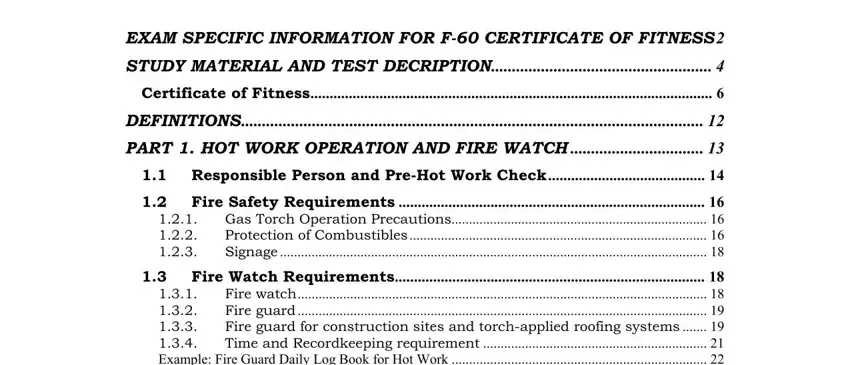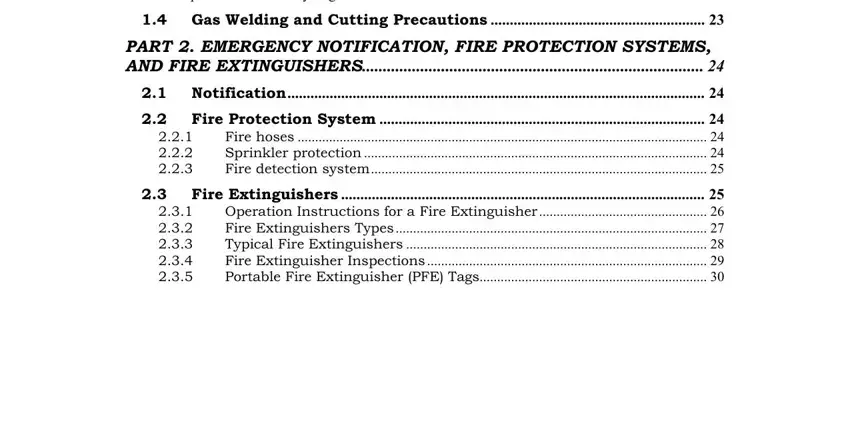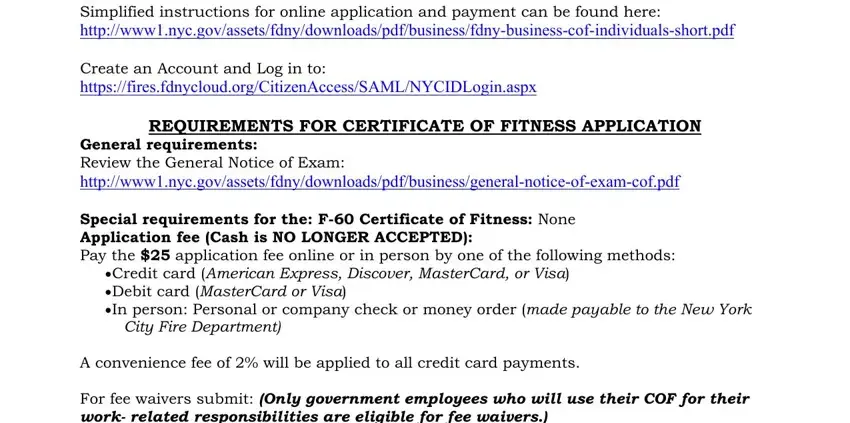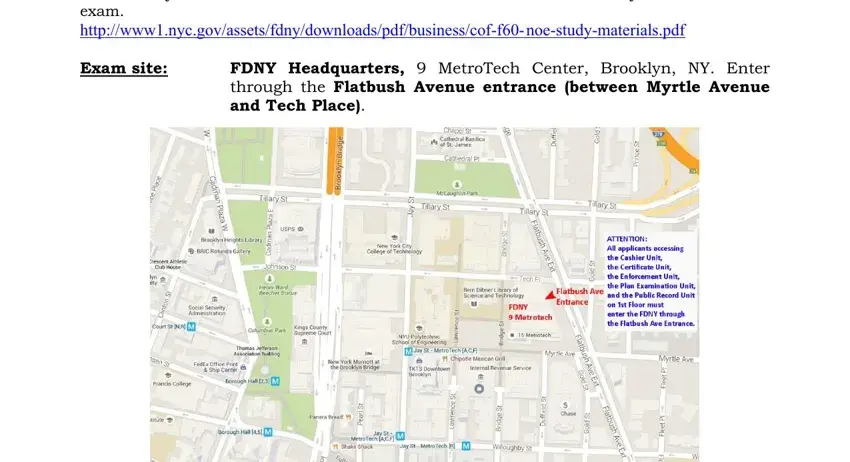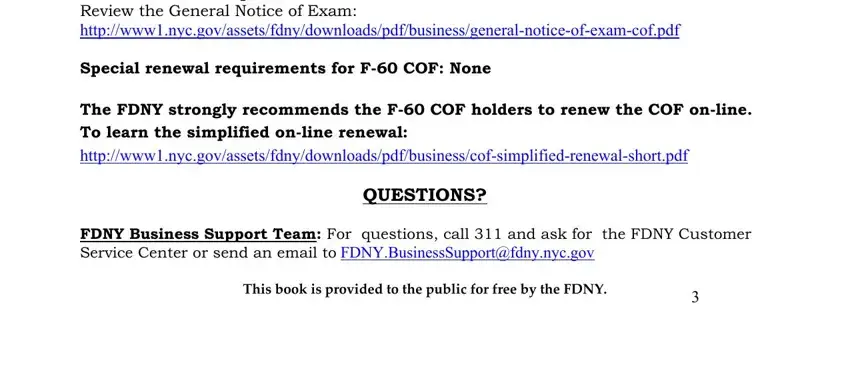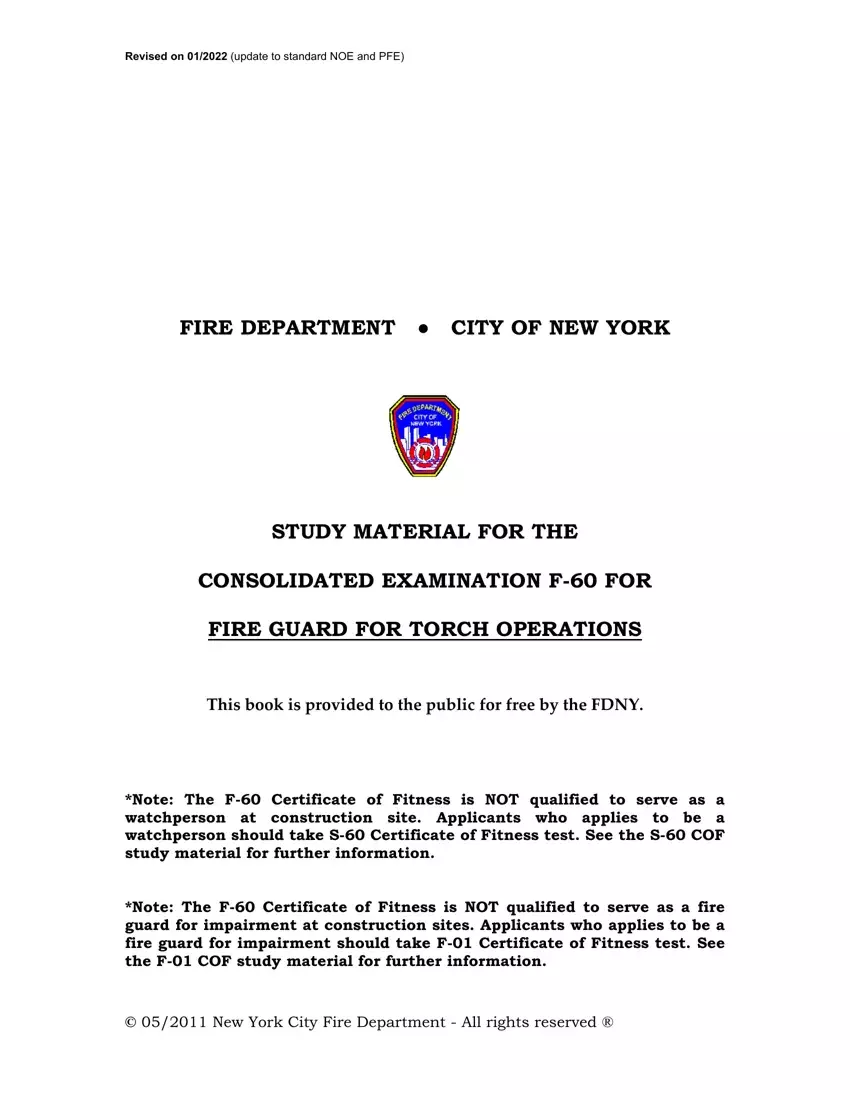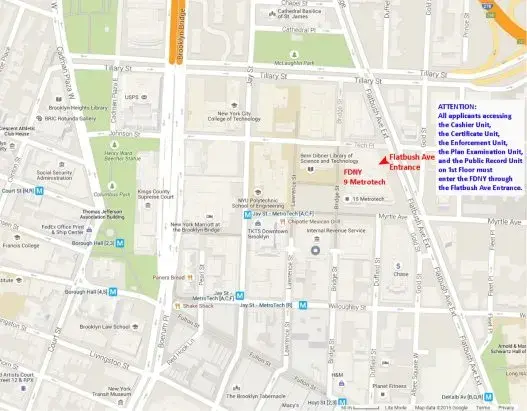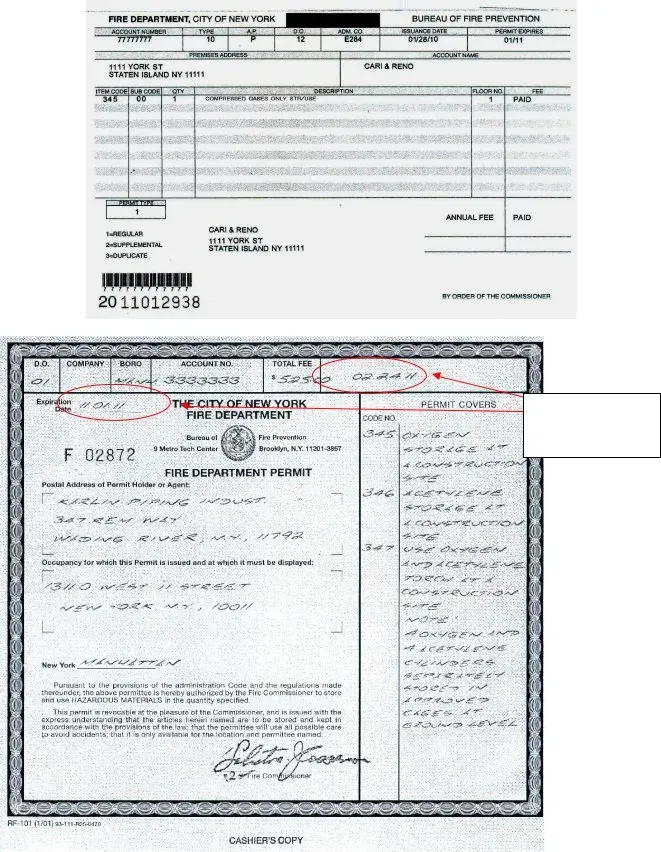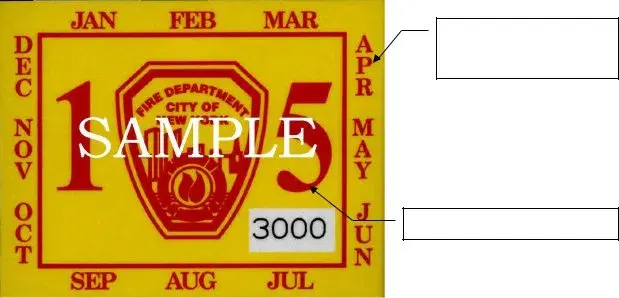Revised on 01/2022 (update to standard NOE and PFE)
FIRE DEPARTMENT ● CITY OF NEW YORK
STUDY MATERIAL FOR THE
CONSOLIDATED EXAMINATION F-60 FOR FIRE GUARD FOR TORCH OPERATIONS
This book is provided to the public for free by the FDNY.
*Note: The F-60 Certificate of Fitness is NOT qualified to serve as a watchperson at construction site. Applicants who applies to be a watchperson should take S-60 Certificate of Fitness test. See the S-60 COF study material for further information.
*Note: The F-60 Certificate of Fitness is NOT qualified to serve as a fire guard for impairment at construction sites. Applicants who applies to be a fire guard for impairment should take F-01 Certificate of Fitness test. See the F-01 COF study material for further information.
© 05/2011 New York City Fire Department - All rights reserved ®
TABLE OF CONTENT
EXAM SPECIFIC INFORMATION FOR F-60 CERTIFICATE OF FITNESS2
|
|
|
|
STUDY MATERIAL AND TEST DECRIPTION |
4 |
Certificate of Fitness |
6 |
DEFINITIONS |
12 |
PART 1. HOT WORK OPERATION AND FIRE WATCH |
13 |
1.1 |
Responsible Person and Pre-Hot Work Check |
14 |
1.2 |
Fire Safety Requirements |
16 |
1.2.1. |
Gas Torch Operation Precautions |
16 |
1.2.2. |
Protection of Combustibles |
16 |
1.2.3. |
Signage |
18 |
1.3 |
Fire Watch Requirements |
18 |
1.3.1. |
Fire watch |
18 |
1.3.2. |
Fire guard |
19 |
1.3.3. |
Fire guard for construction sites and torch-applied roofing systems |
19 |
1.3.4. |
Time and Recordkeeping requirement |
21 |
Example: Fire Guard Daily Log Book for Hot Work |
22 |
1.4 |
Gas Welding and Cutting Precautions |
23 |
PART 2. EMERGENCY NOTIFICATION, FIRE PROTECTION SYSTEMS, |
AND FIRE EXTINGUISHERS |
24 |
2.1 |
Notification |
24 |
2.2 |
Fire Protection System |
24 |
2.2.1 |
Fire hoses |
24 |
2.2.2 |
Sprinkler protection |
24 |
2.2.3 |
Fire detection system |
25 |
2.3 |
Fire Extinguishers |
25 |
2.3.1 |
Operation Instructions for a Fire Extinguisher |
26 |
2.3.2 |
Fire Extinguishers Types |
27 |
2.3.3 |
Typical Fire Extinguishers |
28 |
2.3.4 |
Fire Extinguisher Inspections |
29 |
2.3.5 |
Portable Fire Extinguisher (PFE) Tags |
30 |
This book is provided to the public for free by the FDNY. |
A |
|
EXAM SPECIFIC INFORMATION FOR
F-60 CERTIFICATE OF FITNESS
Save time and submit application online!
Applicants who submitted and paid online for an exam before arriving at the FDNY will not need to wait in line to enter the FDNY.
It can take about 30 minutes to complete. Completing application and paying online will eliminate waiting outside in the long lines.
Simplified instructions for online application and payment can be found here:
http://www1.nyc.gov/assets/fdny/downloads/pdf/business/fdny-business-cof-individuals-short.pdf
Create an Account and Log in to:
https://fires.fdnycloud.org/CitizenAccess/SAML/NYCIDLogin.aspx
REQUIREMENTS FOR CERTIFICATE OF FITNESS APPLICATION
General requirements:
Review the General Notice of Exam:
http://www1.nyc.gov/assets/fdny/downloads/pdf/business/general-notice-of-exam-cof.pdf
Special requirements for the: F-60 Certificate of Fitness: None
Application fee (Cash is NO LONGER ACCEPTED):
Pay the $25 application fee online or in person by one of the following methods:
•Credit card (American Express, Discover, MasterCard, or Visa)
•Debit card (MasterCard or Visa)
•In person: Personal or company check or money order (made payable to the New York City Fire Department)
A convenience fee of 2% will be applied to all credit card payments.
For fee waivers submit: (Only government employees who will use their COF for their work- related responsibilities are eligible for fee waivers.)
•A letter requesting fee waiver on the Agency’s official letterhead stating applicant full name, exam type and address of premises; AND
•Copy of identification card issued by the agency
REQUIREMENTS FOR ALTERNATIVE ISSUANCE PROCEDURE (AIP)
No AIP available. This certificate of fitness can only be obtained by passing the computer exam at the FDNY Headquarters.
EXAM INFORMATION
The F-60 exam will consist of 25 multiple-choice questions, administered on a “touch screen” computer monitor. It is a time-limit exam. Based on the amount of the questions, you will have 38 minutes to complete the test. A passing score of at least 70% is required in order to secure a Certificate of Fitness.
Call (718) 999-1988 for additional information and forms.
This book is provided to the public for free by the FDNY. |
2 |
|
Please always check for the latest revised booklet at FDNY website before you take the exam.
http://www1.nyc.gov/assets/fdny/downloads/pdf/business/cof-f60- noe-study-materials.pdf
Exam site: FDNY Headquarters, 9 MetroTech Center, Brooklyn, NY. Enter through the Flatbush Avenue entrance (between Myrtle Avenue and Tech Place).
RENEWAL REQUIREMENTS
General renewal requirements:
Review the General Notice of Exam:
http://www1.nyc.gov/assets/fdny/downloads/pdf/business/general-notice-of-exam-cof.pdf
Special renewal requirements for F-60 COF: None
The FDNY strongly recommends the F-60 COF holders to renew the COF on-line. To learn the simplified on-line renewal:
http://www1.nyc.gov/assets/fdny/downloads/pdf/business/cof-simplified-renewal-short.pdf
QUESTIONS?
FDNY Business Support Team: For questions, call 311 and ask for the FDNY Customer
Service Center or send an email to FDNY.BusinessSupport@fdny.nyc.gov
This book is provided to the public for free by the FDNY. |
3 |
|
STUDY MATERIAL AND TEST DECRIPTION
About the Study Material
This study material will help you prepare for the examination for the Certificate of Fitness for fire guard for torch operations. The study material includes information taken from the Fire Prevention Code of the Bureau of Fire Prevention. This study material consists of 3 parts. The exam covers the entire booklet and any tables. It will not be provided to you during the test. It is critical that you read and understand this booklet to help increase your chance of passing this exam. The study material does not contain all of the information you need to know to work as a fire guard. It is your responsibility to become familiar with all applicable rules and regulations of the City of New York, even if they are not covered in this study material. You need to be familiar with the National Fire Protection Association (NFPA) 51B, and Fire Code Chapter 26, which regulate the duties of fire guards for performing fire watch for torch operations in order to adequately prepare for the exam.
About the Test
25 questions on the F-60 Certificate of Fitness examination are of the multiple choice type with four alternative answers to each question. Only one answer is most correct for each question. If you do not answer a question, or if you mark more than one alternative your answer will be scored as incorrect. A score of 70% is required on the examination in order to qualify for the Certificate of Fitness. Read each question carefully before marking your answer. There is no penalty for guessing.
Sample Questions
The following questions represent the “format” of the exam questions,
not the content of the real exam.
1.Which of the following are allowed to be used/displayed while taking a Certificate of Fitness examination at 9 Metro Tech Center?
I. cellular phone
II. study material booklet
III.reference material provided by the FDNY IV. mp3 player
A.III only
B.I, II, and III
C.II and IV
D.I only
Only reference material provided by the FDNY is allowed to be used during Certificate of Fitness examinations. Therefore, the correct answer would be A. You would touch “A” on the computer terminal screen.
This book is provided to the public for free by the FDNY. |
4 |
|
2.If you do not know the answer to a question while taking an examination, who should you ask for help?
A. the person next to you B. the firefighters
C. the examiner in the testing room
D. you should not ask about test questions since FDNY staff cannot assist applicants
You should not ask about examination questions or answers since FDNY staff cannot assist applicants with their tests. Therefore, the correct answer would be D. You would touch "D" on the computer terminal screen.
3.If the screen on your computer terminal freezes during your examination, who should you ask for help?
A. the person next to you
B. the firefighters
C. the examiner in the testing room
D. the computer help desk
If you have a computer related question, you should ask the examiner in the testing room. Therefore, the correct answer would be C. You would touch “C” on the computer terminal screen.
This book is provided to the public for free by the FDNY. |
5 |
|
INTRODUCTION
This document outlines New York City Fire Department regulations for fire guard for hot work operations. Fire guards are required to reduce the threat of fires.
Certificate of Fitness
The fire watch for torch operations conducted at the following three locations shall be conducted by at least one F-60 fire guard:
(1)Construction sites.
(2)In any building or structure, when the torch operation is conducted by a person holding a citywide permit for torch operations.
(3)On any rooftop, or in connection with any torch-applied roofing system operation.
The Certificate of Fitness holder must keep the Certificates of Fitness upon his or her person, or otherwise readily available for inspection by any representative of the Department, at all times while conducting or supervising the material, operation or facility for which the certificate is required.
The F-60 Certificate of Fitness holder is required to comply with the following FDNY code and rule sections:
•Welding and Other Hot Work: [FC Chapter 26]
•Fire Prevention During Welding, Cutting and Other Hot Work: [NFPA 51B, 2003 edition]
•Liquefied Petroleum Gases: [Rule 3809-01]
•Compressed Natural Gas [Rule 3507-01]
FDNY Permit
Permits issued by the FDNY are required to conduct the following hot work:
(1)storing, using or handling oxygen and a flammable gas, or
(2)storing, using or handling any flammable gas (e.g. LPG or CNG or acetylene) in excess of 400 SCF.
or
(3)storing, using or handling any oxidizing gas (e.g. oxygen) in excess of 504 SCF
For LPG, 400 SCF is approximately 47 lbs. The following table lists the number of LPG containers for the storage, use, handling or transportation, requiring a permit. This permit will be issued by the Fire Commissioner after the location has been inspected and approved as acceptable for such practices.
LPG Container Capacity |
Number of Containers Requiring Permit |
14.1 oz |
54 |
16.4 oz |
46 |
20 lbs |
3 |
33.5 lbs |
2 |
40 lbs |
2 |
100 lbs |
1 |
This book is provided to the public for free by the FDNY. |
6 |
|
Portable LPG containers that are more than 16.4 oz and CNG containers with a capacity greater than 8.7 SCF must NOT stored, handled, or used indoors/roof in the following occupancies (as defined in the Building code): residential occupancies, factory and industrial occupancies; educational occupancies; institutional occupancies, except as the commissioner may authorize by rule.
Use of LPG/Propane on an occupied roof requires an affidavit from a licensed professional (Architect or Engineer) stating the roof is constructed of non-combustible material(s).
Any single standard portable LPG container must not exceed 100 lbs in weight. Any single CNG container must not exceed 381 SCF.
A LPG/CNG permit will not be issued by the FDNY for a stationary LPG/CNG installation located in an area where access to piped natural gas from a public utility is available.
Example of LPG container with a capacity of 20 lbs
Example of LPG container with a capacity of 100 lbs
Types of FDNY Permits
(1) Site-specific permit
Such permit authorizes the permit holder to store, handle, or use flammable gases, or conduct a torch operation at a specific premises or location. A site-specific permit may be a permanent permit or a temporary permit. Permanent permits are valid for 12 months only. Every permits or renewal shall require an inspection and shall expire after twelve months. Temporary permit may be valid from one day to 12 months depends on the construction /operation need. For example, a one-week temporary permit may be issued to a construction job which only takes one week. Normally, a hot work operation (e.g. construction site or hot work repair) is issued a temporary permit.
Example of a permanent FDNY permit
This book is provided to the public for free by the FDNY. |
7 |
|
Example of a temporary FDNY permit
This temporary permit is valid for 7 months.
This book is provided to the public for free by the FDNY. |
8 |
|
(2) Citywide permit
Such permit authorizes the permit holder to store, handle, use or sell hazardous materials, or conduct an operation on a citywide basis. A citywide permit is valid to temporarily store, handle, use or sell hazardous materials or to conduct an operation at one or more locations subject to the following restrictions:
•The duration of such activity at any individual location does not exceed 30 calendar days and all hazardous materials associated with such activity are removed from the location at the end of the workday. Periods of activity in excess of 30 calendar days at any one location shall require a site-specific permit.
•The quantity of hazardous materials being temporarily stored and used does not exceed 5 gallons of gasoline, or 250 gallons of any other flammable liquid, and 300 gallons of any combustible liquid. Storage or use of hazardous materials in quantities exceeding these amounts requires a site-specific permit for each location at which such storage or use occurs.
(3)Transportation permit
Such permit authorizes the permit holder to transport, pick up and deliver hazardous materials. Any person who transports any hazardous material in the quantity of requiring a FDNY permit has to apply for a FDNY transportation permit. The FDNY transportation permit (sticker) must be displayed on the vehicle.
Example of a FDNY transportation permit (a sticker)
Month of inspection (will be punched)
Year that permit expires
All permits are not transferable, and any change in occupancy, operation, tenancy or ownership requires that a new permit be issued. The Certificate of Fitness holder is responsible for making sure that all fire safety regulations and procedures are obeyed on the premises. Permits shall be readily available on the premise for inspection by Fire
Department representatives.
Hot Work Authorization (Hot Work Program Permit)
A hot work program authorization is required for any project conducted on premises involving hot work operations. Hot work program authorization is NOT issued by the FDNY, it must be signed and issued by the responsible person, and it must be available for
This book is provided to the public for free by the FDNY. |
9 |
|
